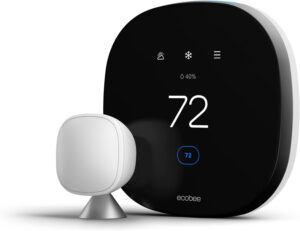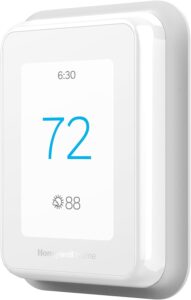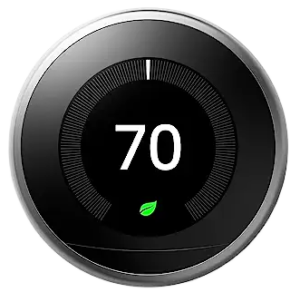In the realm of home automation and energy efficiency, smart thermostats stand out as both a functional and stylish addition to any modern home. These devices, far more advanced than their traditional counterparts, offer homeowners an unprecedented level of control over their heating, ventilation, and air conditioning (HVAC) systems. This not only ensures optimal comfort within the living space but also contributes significantly to energy savings.
Below, we delve into the mechanics behind smart thermostats, their benefits, and how they seamlessly integrate into the smart home ecosystem to provide both cost savings and a step towards a more sustainable lifestyle.

What Are Smart Thermostats?
Smart thermostats leverage cutting-edge technology, including Wi-Fi connectivity and artificial intelligence, to automate and optimize home temperature settings. Unlike traditional thermostats that require manual adjustments, smart thermostats adapt to your habits and preferences, adjusting the temperature automatically for both efficiency and comfort.
Saving Money with a Smart Thermostat
The primary allure of smart thermostats lies in their potential for energy savings, which translates directly into cost savings on utility bills. Here are several ways how smart thermostats achieve this:
- Precision Temperature Control: Smart thermostats maintain a consistent temperature, learning from your patterns to optimize heating and cooling cycles, thus preventing energy waste.
- Personalized Scheduling: They allow for the creation of detailed schedules that align with daily routines, reducing energy usage when the house is empty or during off-peak hours.
- Geofencing Technology: Utilizing the GPS in your smartphone, smart thermostats adjust the home’s temperature based on your proximity to the house, ensuring energy is not wasted when no one is home.
- Energy Usage Insights: With detailed reports on energy consumption, homeowners can make informed decisions to further reduce energy usage.
- Integration with Smart Home Devices: When paired with other smart devices, such as smart blinds or lights, smart thermostats can further enhance energy savings and comfort.
- Remote Monitoring and Adaptive Learning: The ability to monitor and adjust your home’s temperature from anywhere combined with the thermostat’s ability to learn and adapt to your habits maximizes energy efficiency over time.
Maximizing Savings with Smart Thermostats
The savings potential of smart thermostats varies depending on factors such as climate, home size, and energy rates. However, certain scenarios can significantly enhance the benefits of smart thermostats:
- Homes with zoned HVAC systems can achieve precise temperature control in different areas, optimizing energy use.
- Regions with extreme weather conditions or high energy rates stand to benefit the most from the energy-saving capabilities of smart thermostats.
- Vacation homes can maintain energy-efficient settings when unoccupied, leading to substantial savings.
Best Thermostats for Smart Homes
Google Nest Learning Thermostat:
The Google Nest Learning Thermostat is a frontrunner in the realm of smart thermostats, renowned for its ability to learn your schedule and temperature preferences within a week of use. This device automatically adjusts the temperature to save energy when you’re away and can be controlled remotely via the Nest app. Its sleek design, featuring a high-resolution color display, blends seamlessly with any home decor.
Moreover, the Nest Learning Thermostat provides energy usage reports, helping you understand your consumption patterns and identify opportunities for additional savings.
Learn More About Google Nest Learning Thermostat .
Ecobee Smart Thermostat with Voice Control:
Ecobee’s flagship thermostat combines robust temperature management features with built-in Alexa voice control, offering not just convenience but also a central hub for controlling other smart home devices. It comes with a SmartSensor, which helps manage hot or cold spots in different rooms, ensuring consistent comfort throughout your home.
The Ecobee SmartThermostat supports Apple HomeKit, Google Assistant, and Samsung SmartThings, making it a versatile choice for various smart home ecosystems.
Check out Ecobee’s flagship thermostat .
Honeywell Home T9 Smart Thermostat:
The Honeywell Home T9 Smart Thermostat is designed with multi-room sensing and geofencing technology, ensuring comfort where it matters most. It’s compatible with Alexa and Google Assistant, allowing for easy voice control.
The T9’s smart room sensors detect temperature and humidity, directing focus to the room you’re in or the rooms you prioritize, for more targeted comfort and efficiency.
Discover The Honeywell Home T9 Smart Thermostat .
Emerson Sensi Touch Wi-Fi Smart Thermostat:
The Emerson Sensi Touch offers a budget-friendly option without sacrificing performance. It features a touchscreen display for easy adjustments and programming, and it’s compatible with most HVAC systems.
The Sensi Touch provides alerts for extreme temperatures and humidity levels, ensuring your home remains within your preferred comfort zone. It also integrates with Alexa, Google Assistant, and Apple HomeKit for comprehensive smart home connectivity.
Explore Emerson Sensi Touch Wi-Fi Smart Thermostat .
Wyze Thermostat:
Wyze offers an affordable smart thermostat that doesn’t skimp on features. It allows for easy scheduling, remote access via the Wyze app, and usage tracking to monitor your energy consumption.
The Wyze Thermostat supports Alexa and Google Assistant for voice control and offers a simple, intuitive interface for manual adjustments.
Learn More About Wyze .
Conclusion
Smart thermostats represent a fusion of convenience, efficiency, and style, offering homeowners a powerful tool for energy management. By adapting to your lifestyle, providing valuable insights into energy usage, and integrating seamlessly with other smart home technologies, smart thermostats not only enhance the comfort of your living space but also contribute to a more sustainable future. As we continue to embrace smart home technologies, the smart thermostat remains a cornerstone in achieving both energy savings and environmental stewardship.



